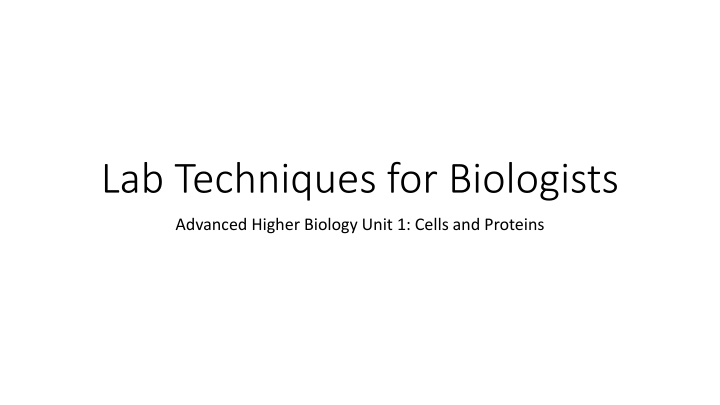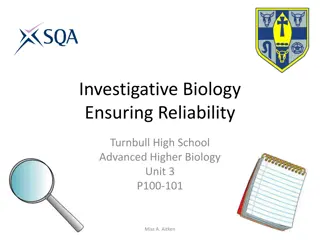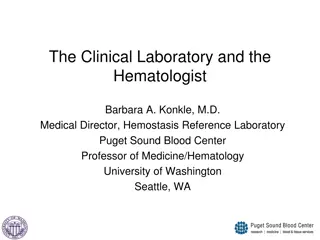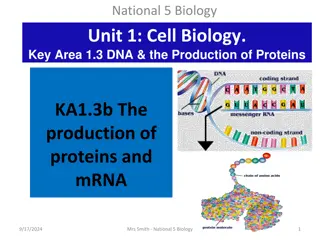Laboratory Techniques for Biologists: Advanced Biology Unit Overview
Explore essential topics in the field of advanced biology including health and safety protocols, risk assessments, dilution methods, colorimetry, separation techniques like chromatography and electrophoresis, and more. Gain insights on handling hazardous substances, controlling risks, and applying various laboratory techniques for cell and protein studies.
Download Presentation

Please find below an Image/Link to download the presentation.
The content on the website is provided AS IS for your information and personal use only. It may not be sold, licensed, or shared on other websites without obtaining consent from the author.If you encounter any issues during the download, it is possible that the publisher has removed the file from their server.
You are allowed to download the files provided on this website for personal or commercial use, subject to the condition that they are used lawfully. All files are the property of their respective owners.
The content on the website is provided AS IS for your information and personal use only. It may not be sold, licensed, or shared on other websites without obtaining consent from the author.
E N D
Presentation Transcript
Lab Techniques for Biologists Advanced Higher Biology Unit 1: Cells and Proteins
Section 1: Health and Safety Mandatory knowledge from the SQA Course Notes: Substances, organisms and equipment in a laboratory can present a hazard. Hazard, risk and control of risk in the lab by risk assessment. Hazards in the lab: toxic chemicals, corrosive chemicals, heat, flammable substances, pathogenic organisms and mechanical equipment. Risk is the likelihood of harm arising from exposure to a hazard A risk assessment involves identifying control measures to minimise the risk. Control measures include using appropriate handling techniques, protective clothing, protective equipment and aseptic technique.
More Information on Risk Assessments https://www.york.ac.uk/biology/intranet/health-safety/risk-assessments/#tab-1 What do I need to know? - A brief overview of a what a risk assessment is, what it looks like and how/when it is carried out.
Bright Red Textbook Pages 10 - 11 Section 2: Liquids and Solutions Mandatory knowledge from the SQA Course Notes: Methods and uses of linear and log dilution; standard curve for determination of an unknown; buffers to control pH; colorimeter to quantify concentration and turbidity. Why are dilutions used? What is a linear dilution and how is it made? What is a log dilution and how is it made? What is a colorimeter and what does it do? What can it be used for? What is a standard curve and how is it used to determine an unknown? What is a buffer? Why is it essential that hazards are identified? What control measures can be put in place?
Bright Red Textbook Pages 12-13 Section 3: Separation Techniques Mandatory knowledge from the SQA Course Notes: Use of a centrifuge to separate substances of differing density. Paper, thin layer and affinity chromatography for separating amino acids, proteins and sugars. Protein electrophoresis uses current flowing through a buffer to separate proteins. Size, shape and charge are factors affecting protein migration in a gel. SDS-page separates proteins by size alone. Proteins can be separated using pH; at their iso-electric point they have an overall neutral charge and precipitate out of solution. What is the purpose of centrifugation? How is this carried out? What is the purpose of paper/thin-layer chromatography? What is the purpose of affinity chromatography? What is the purpose of protein electrophoresis? What factors affect? What is a proteins iso-electric point? How does that help us to separate? Example? SDS-PAGE is new for 2019
Affinity Chromatography Affinity chromatography is a technique for separating one protein from a mixture. An antibody or ligand specific to the protein in question is immobilised in a jelly inside a column. A mixture of proteins is then added to the column.
Only the protein specific to the ligand or antibody will bind to it. The rest will sit in the gel until they are washed out or travel down and fall out of the bottom of the column.
To get the specific protein bound to the antibody or ligand, the column must be washed. The column is washed with either a buffer (lowering the pH and affinity) or a solution containing free ligand that the protein then binds to.
Separating Proteins Gel Electrophoresis SDS Page (a type of gel electrophoresis) Uses current flowing through a buffer to separate molecules by size alone. Uses current flowing through a buffer to separate molecules by size and charge Molecules are in their unfolded state (non-native/denatured) Molecules are in their folded state (native) This is done by heating the molecules with detergent.
Isoelectric Point The pH at which a protein has NO CHARGE. It is in a neutral state and is neither positively nor negatively charged. Remember: proteins which are soluble will either be positive or negative. Proteins are insoluble at their ISOELECTRIC POINT. This means they will form a precipitate (solid). They will be able to separated from a solution of soluble proteins at this point.
Bright Red Textbook Pages 14-15 Section 4: Antibody Techniques Mandatory knowledge from the SQA Course Notes: Immunoassay techniques are used to detect and identify specific proteins. These techniques use stocks of antibodies with the same specificity, known as monoclonal antibodies. An antibody specific to the protein antigen is linked to a chemical label. Western blotting is a technique, used after SDS-PAGE electrophoresis. The separated proteins from the gel are transferred (blotted) onto a solid medium. The proteins can be identified using specific antibodies that have reporter enzymes attached. What is an immunoassay technique? How are serums containing antibodies harvested? What is a polyclonal serum? What are monoclonal antibodies and how are they produced? Explain the process of ELISA What is western blotting? What is fluorescent-immunohistochemical staining?
What is an immunoassay technique? Used in laboratory studies Allows scientists to detect and identify specific proteins There are a number of different immunoassay techniques, but they all rely on the same fact: each specific antibody binds to and inactivates specific antigens. This means that in a mixture of proteins, an antibody can bind to a specific antigen. This can be detected by different methods.
How do we get a source of antibodies? A serum containing antibodies can be harvested from the blood of animals that have been exposed to a specific pathogen. The blood is then centrifuged and the antibodies are separated. A serum with many different antibodies in it is called polyclonal. To carry out immunoassay techniques, a stock of identical antibodies are required. This is called a monoclonal serum. This ensures that the antibodies will bind to exactly the same feature of the antigen. They are produced by growing a single line of lymphocytes, each secreting the same antibody.
Immunoassay techniques using reporter enzymes A reporter enzyme is an enzyme that catalyses/causes a colour change. This makes it easy to see if a reaction has happened. ELISA is an immunoassay technique that uses reporter enzymes. Pregnancy testing kits use an immunoassay technique to change colour. Kits test for the presence of human chorionic gonadotrophin (HCG) which is a hormone only produced by the placenta.
Steps in ELISA 1. Antibodies are attached to the bottom of a plastic well 2. A test sample is then added, and if the sample contains the specific antigen, it will bind to the antibody. 3. Next, a second antibody is added. This will bind only to the antigen. This antibody is enzyme-linked, which means a reporter enzyme is bound to the other side of it. 4. A solution containing the reporter enzyme s substrate is added. This causes a colour change and will confirm that the protein is in the mixture.
So what does ELISA show us? When carrying out this ELISA experiment, a colour change will only occur if the protein we are looking for is present in the test sample at stage 2. If it isn t there, enzyme-linked antibodies will not join, a substrate will not join to the reporter enzyme and a colour change will not be observed.
Example: Pregnancy Testing Kits Example: Pregnancy Testing Kits Testing stick has antibodies on it. Sample does not contain HCG hormone and it s antigen Enzyme-linked antibody in the stick do not bind to HCG antigen (because it isn t there) Test sample is added Sample contains HCG hormone and it s antigen Substrate in the stick does not bind to enzyme-linked antibody (because it s not there) Enzyme-linked antibody in the stick bind to HCG antigen Colour change does not occur Shows: Not Pregnant Substrate in the stick binds to enzyme-linked antibody Colour change occurs (thanks to reporter enzyme) Shows: Pregnant
ELISA: Problems The biggest problem with ELISA is a false positive being shown. To ensure that this does not happen in the lab, the test wells are thoroughly washed between each stage.
Western Blotting Western blotting is a technique used after SDS-Page. Remember, SDS-page separates proteins by their size! Once proteins are separated, the gel is transferred (blotted) onto a solid medium (usually thin film like photography film). Specific proteins can then be identified by adding an antibody that has a reporter enzyme attached, then adding the enzymes substrate, causing a colour change.
Section 5: Microscopy Mandatory knowledge from the SQA Course Notes: Bright field microscopy is commonly used to observe whole organisms, parts of organisms, thin sections of dissected tissue or individual cells. Fluorescence microscopy uses specific fluorescent labels to bind to and visualise certain molecules or structures within cells or tissues.
Fluorescent-immunohistochemical staining A way of looking at where specific cellular components are in live cells Fluorescence microscopy uses specific fluorescent labels to bind to and visualise certain molecules or structures within cells or tissues. These labels are antibodies, which are fluorescent.
Bright Field Microscopy Used to examine: whole organisms parts of organisms Sections of dissected tissue Individual cells You ve used bright field microscopy before, but in many labs the magnification can go from x400 to x1000! Stains are often used to show parts of the cells more clearly.
Section 6: Aseptic technique and cell culture Bright Red Textbook Pages 16-17 Mandatory knowledge from the SQA Course Notes: Aseptic technique eliminates unwanted microbial contaminants when culturing micro- organisms or cells. A microbial culture can be started using an inoculum of microbial cells on an agar medium, or in a broth with suitable nutrients. Animals cells are grown in medium containing growth factors from serum. In culture, primary cell lines can divide a limited number of times, whereas tumour cell lines can perform unlimited divisions. Plating out of a liquid microbial culture on solid media allows the number of colony-forming units to be counted and the density of cells in the culture estimated. Serial dilution is often needed to achieve a suitable colony count. Method and use of haemocytometer to estimate cell numbers in a liquid culture. Vital staining is required to identify and count viable cells What is aseptic technique? How is a microbial culture started? What is a growth factor? What is an animal serum? How are cell lines created? What is an immortal cell line? How is a haemocytometer used? What is a vital stain? Give an example
Aseptic Technique A set of precautions taken to eliminate unwanted microbial contamination. Sterilise equipment Wash hands Bleach down desk Keep lids on all cultures and plates as much as possible
Microbial Culture A culture is the name given to the growth of micro-organisms Growing a culture: Can be done in suspension (a liquid broth) or on a substrate (a solid medium like an agar plate) Microbial cultures are started using an inoculum where growing cells are added to liquid containing nutrients. To get the growing cells for the inoculum, you must touch a sterile loop to a plate or broth containing microbes.
Animal Cell Culture Cultured in a liquid Require addition of chemical growth factor to promote cell growth and cell division May also add proteins, salts, vitamins and glucose Antibiotics are often added to prevent bacterial growth Foetal Bovine Serum (FBS) is an example of serum that contains growth factors and many other chemical components.
Animal Cell Culture Animal cells in culture tend to die after about 60 divisions This is known as the Hayflick Limit This reduces the length of time a primary cell culture can be maintained and used. Therefore, in scientific research, tumour cell lines are normally used. They do not conform to the Hayflick limit, and are immortal. They perform unlimited divisions.
Plating Out Taking a liquid microbial culture and putting some of the liquid onto a solid medium such as an agar plate is known as plating out . You can estimate the number of bacterial colonies in a culture by doing this. For example, if you find that 1 l of a liquid gives you 9 colonies, how many colonies would be in your entire culture, if the volume of the culture is 100ml?
Haemocytometer A method of counting cell density A known volume of a culture is added to a microscope slide, and a grid is placed over it. By counting the number of cells in a particular area of the grid, a cell density can be calculated. This can then be multiplied to find the cell density of the entire solution you have taken the sample from.
Vital Staining A vital stain is used to distinguish living cells from dead cells Vital stains only colour dead cells. For example, methylene blue is a vital stain which leaves living cells colourless but colours in dead cells blue. Why use a vital stain? If we can distinguish living cells from dead cells under a haemocytometer, we can calculate what density of the culture is viable (living). This may only be a small percentage of the entire culture.























